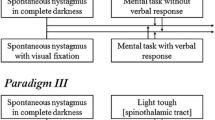Abstract
• Background: Activation of muscle spindles by vibration of eye muscles is known to induce illusory movements of fixated targets, but the effects on eye position have not been studied, either in normal subjects or in patients with exotropia. • Methods: Eye position was recorded from the covered, non-dominant eye with an infrared system in 11 subjects with normal eyes and binocular vision and in 10 patients with exotropia and abnormal binocular function. Activation of eye muscle spindles was done by vibration at 70 Hz of the inferior and lateral rectus muscles of the dominant eye, fixating a light-emitting diode in subdued light. • Results: Vibratory activation of proprioceptors in the inferior rectus muscle induced an eye movement mainly directed upward in both normal and exotropic subjects. The magnitude of the movement was on average 2.7 deg in normals and 2.4 deg in exotropes. Lateral rectus vibration induced a movement that was mainly temporally directed (abduction) of an average 2.1 deg in normal subjects, but a nasally directed (adduction) movement of 4.2 deg in exotropic subjects. In normal subjects the eye movement is of the same direction as the earlier reported visual illusory movements induced by the same type of proprioceptive activation, but in exotropic subjects the movements is in the opposite direction. • Conclusions: Proprioceptive activation of eye muscles affects eye position, and the results also indicate that signals from eye muscles are processed differently in normals and strabismics, probably depending on the level of binocular function.
Similar content being viewed by others
References
Biguer B, Donaldson IHL, Hein A, Jeannerod M (1988) Neck muscle vibration modifies the representation of visual motion and direction in man. Brain 111: 1405–1424
Buisseret P (1995) Influence of extraocular muscle proprioception on vision. Physiol Rev 75:323–338
Campos EC (1995) Amblyopia. Surv Ophthalmol 40:23–39
Dunlop DB, Dunlop P, Fenelon B (1973) Vision-laterality analysys in children with reading disabilities: the results of new techniques of examination. Cortex 9:227–236
Gauthier GM, Nommay DN, Vercher JL (1990) Ocular muscle proprioception and visual localization of targets in man. Brain 113: 1857–1871
Goodwin GM, McCloskey DI, Matthews PBC (1972) The contribution of muscle afferents to kinaesthesia shown by vibration induced illusions of movement and by the effect of paralysing joint afferents. Brain 95:705–748
Hagbarth KE, Eklund G (1966a) Motor effects of vibratory muscle stimuli in man. In: Granit R (ed) Muscle afferents and motor control. Almqvist and Wiksell, Stockholm, pp 177–186
Hagbarth KE, Eklund G (1966b) Tonic vibration reflexes (TVR) in spasticity. Brain Res 2:201–203
Han Y, Lennerstrand G (1995) Eye movements in normal subjects induced by vibratory activation of neck muscle proprioceptors. Acta Ophthalmol Scand 73:414–416
Kommerell G (1984) Discussion remarks to a paper by Mitsui et al. In: Reinecke R (ed) Strabismus Il. Grune and Stratton, Orlando, pp 439–442
Lennerstrand G (1988) Motor and sensory functions of normal and strabismic extracellular muscle. In: Lennerstrand G, Noorden GK von, Campos E (eds) Strabismus and amblyopia. Macmillan, London, pp 4763
Lennerstrand G, Roll JP, Tian S, Roll R, Velay JL, Han Y, Berard PV (1991) Proprioceptive effects on eye position in exotropia. In: Tillson G (ed) Transactions of the VIIth International Orthoptic Congress, Nuremberg, pp 209–213
Lennerstrand G, Han Y, Velay JL (1996) Properties of eye movements induced by activation of neck muscle proprioceptors. Graefe's Arch Exp Ophthalmol 234:703–709
Matthews PBC (1982) Where does Sherrington's “muscle sense” originate? Muscles, joints, corollary discharges? Annu Rev Neurosci 5:189–218
Mitsui Y (1986) Strabismus and the sensory motor reflex. (Current clinical practice series Vol 30) Excerpta Medica, Amsterdam
Mitsui Y, Tamura O (1981) Proprioception and exodeviations. Br J Ophthalmol 65: 578–584
Noorden GK von (1988) Discussion remarks. In: Lennerstrand G, Noorden GK von, Campos E (eds) Strabismus and amblyopia. Macmillan, London, pp 147–148
Roll JP, Roll R (1987) Kinaesthetic and motor effects of extraocular muscle vibration in man. In: O'Regan JK, Schoen AL (eds) Eye movements: from psychology to cognition. North-Holland, Amsterdam, pp 57–68
Roll JP, Vedel JP (1982) Kinaesthetic role of muscle afferents in man studied by tendon vibration and microneurography. Exp Brain Res 47: 117–130
Roll JP, Gilhodes JC, Tardy-Gervet MF (1980) Effects perceptifs et moteurs des vibrations musculaires chez l'Homme normal: mise en évidence d'une réponse des muscles antagonistes. Arch Ital Biol 118:57–71
Roll JP, Velay JL, Roll R (1991) Eye and neck proprioceptive messages contribute to the spatial coding of retinal input in visually-oriented activities. Exp Brain Res 85:423–431
Steinbach MJ (1987) Proprioceptive knowledge of eye position. Vision Res 27:1737–1744
Velay JL, Roll R, Lennerstrand G, Roll JP (1994) Eye proprioception and visual localization in human: influence of ocular dominance and visual context. Vision Res 34:2169–2176
Author information
Authors and Affiliations
Rights and permissions
About this article
Cite this article
Lennerstrand, G., Tian, S. & Han, Y. Effects of eye muscle proprioceptive activation on eye position in normal and exotropic subjects. Graefe's Arch Clin Exp Ophthalmol 235, 63–69 (1997). https://doi.org/10.1007/BF00941731
Received:
Accepted:
Issue Date:
DOI: https://doi.org/10.1007/BF00941731




